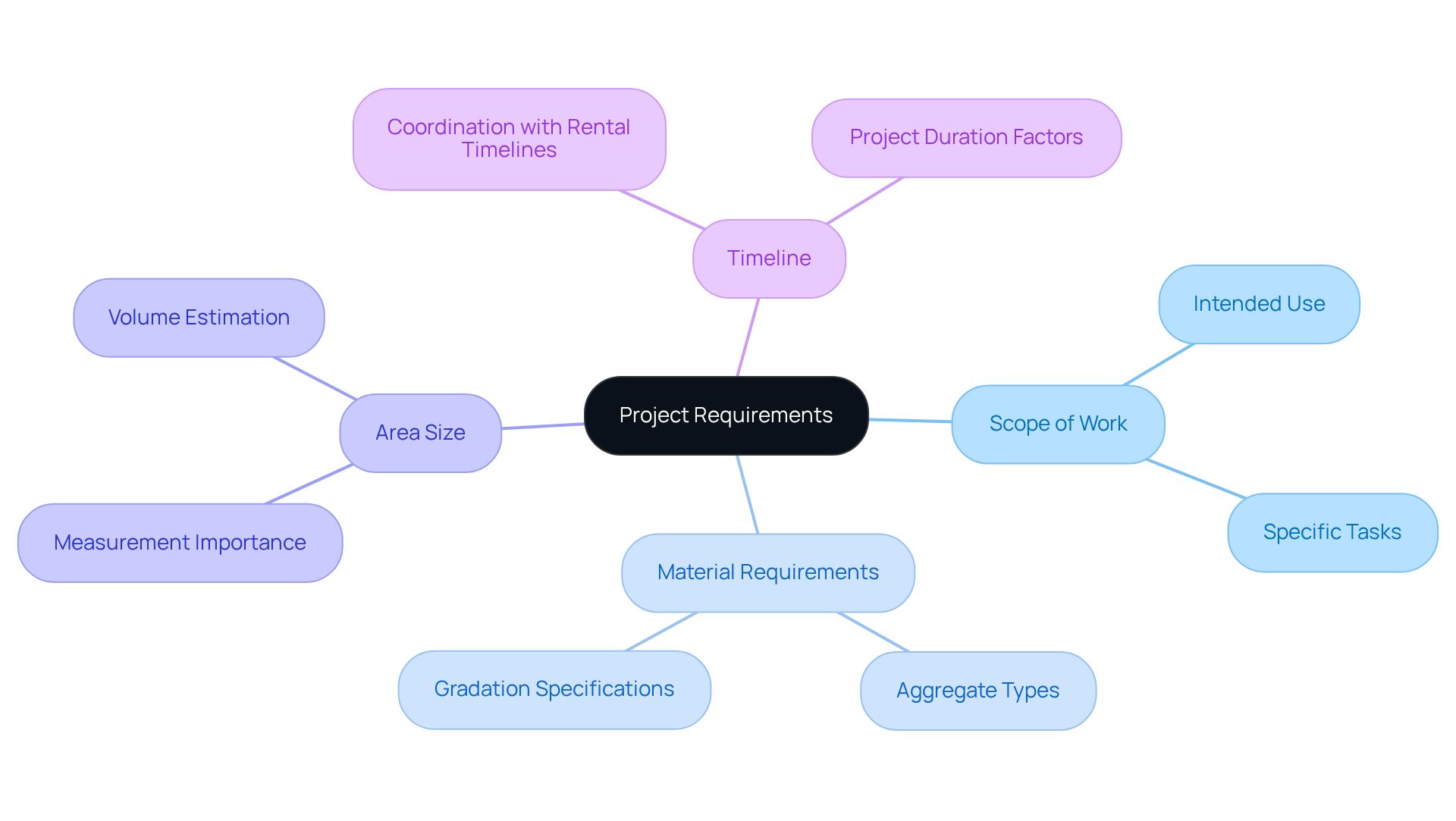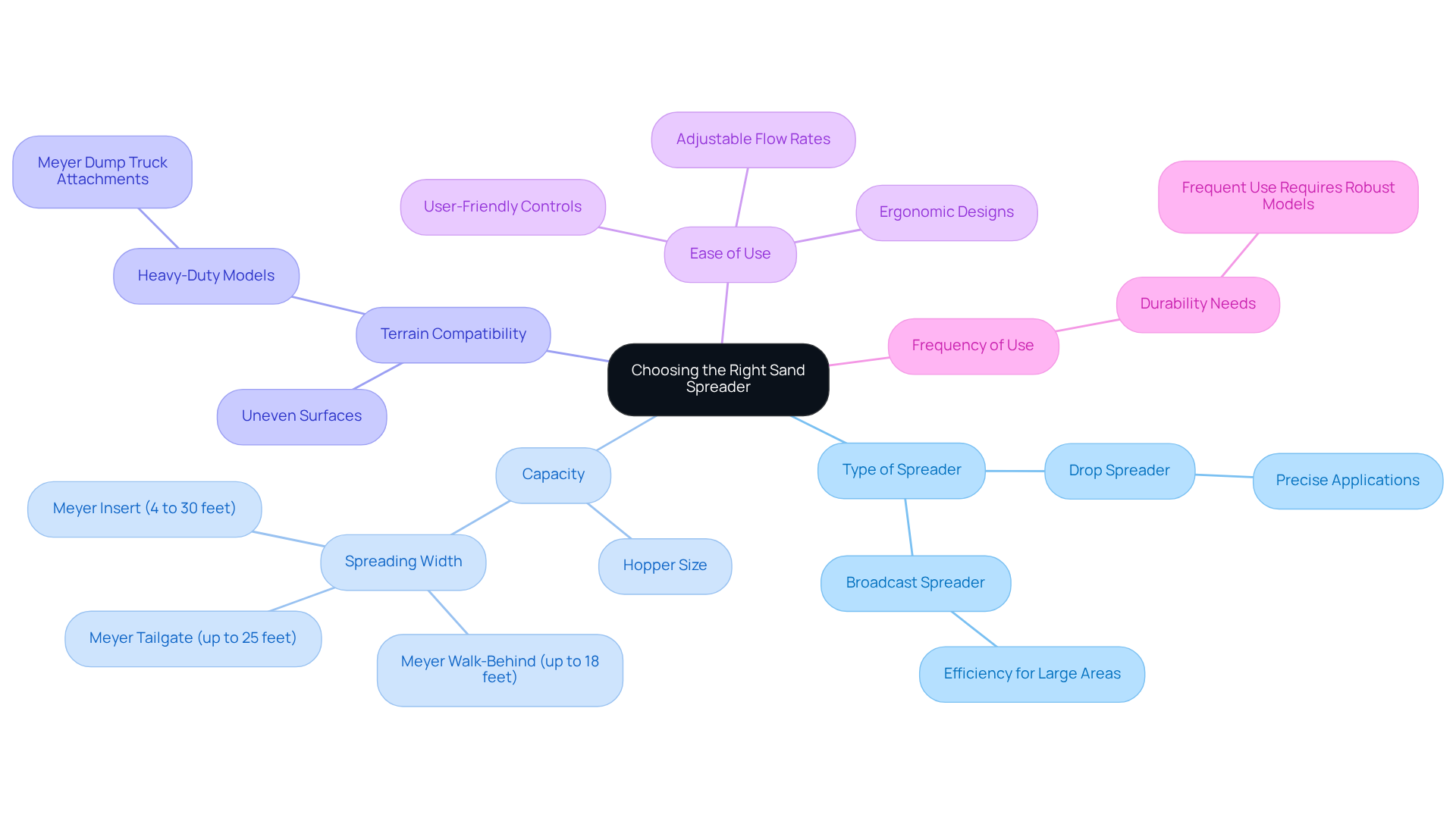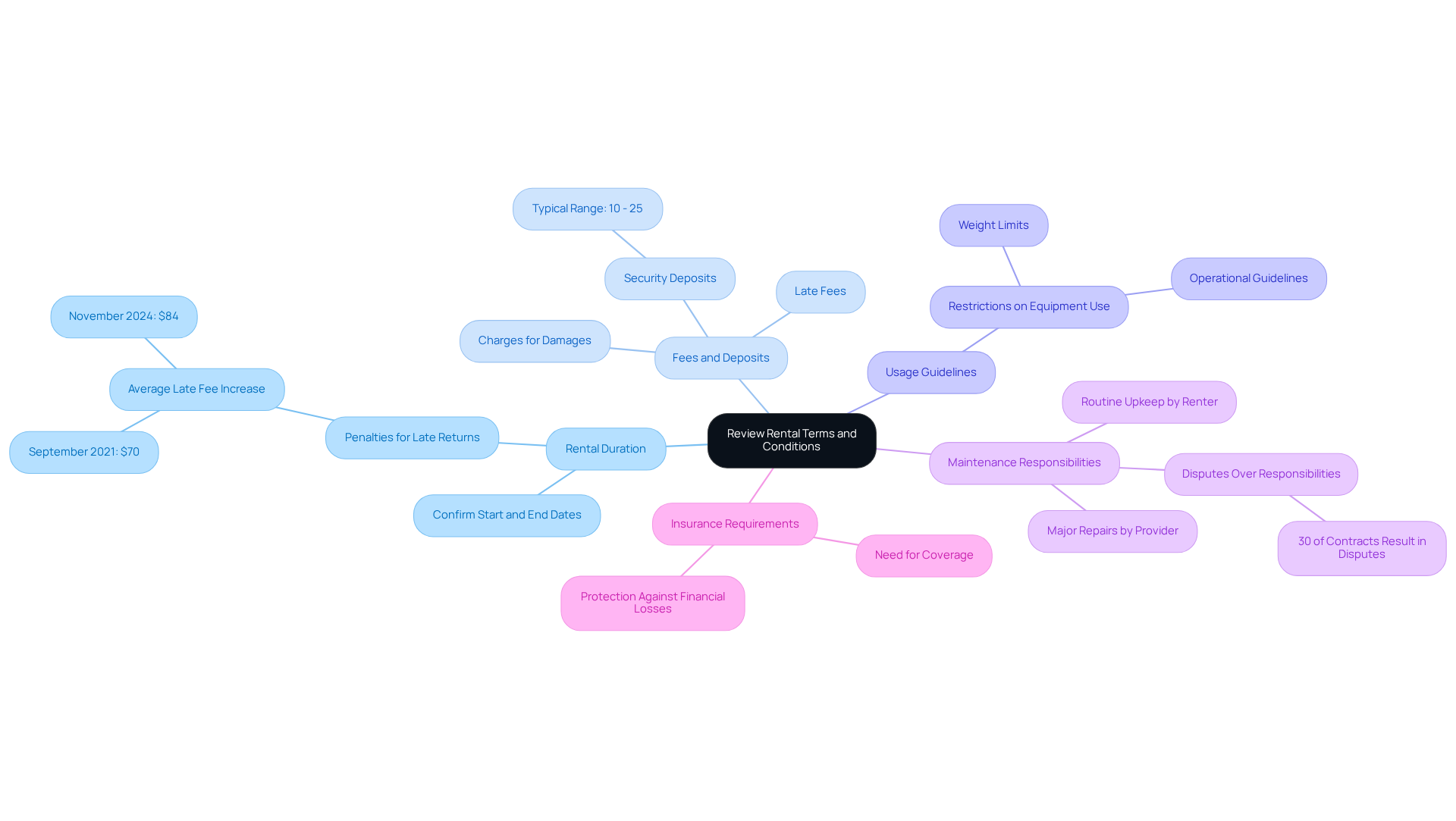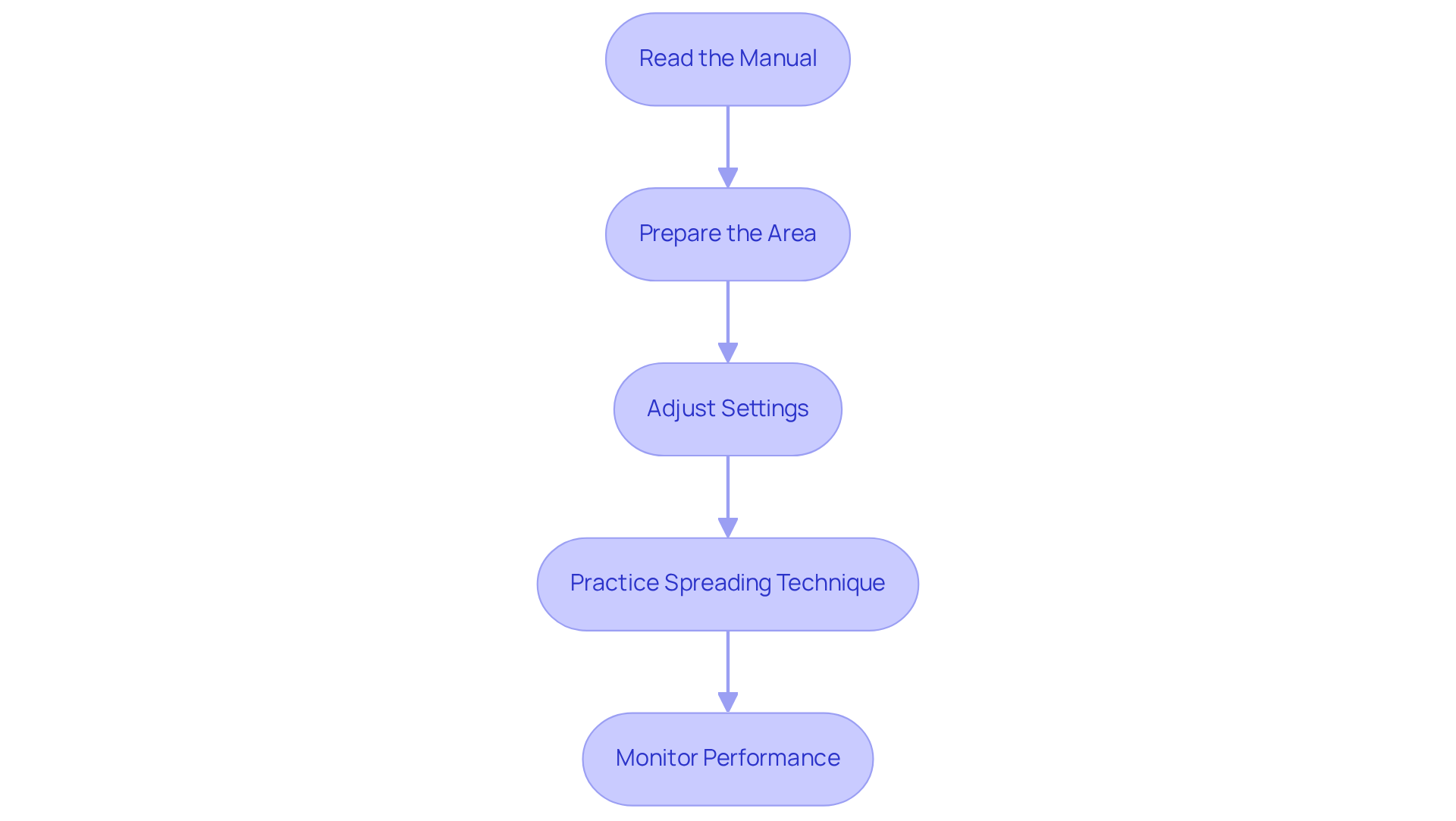Overview
This article presents a detailed five-step process for renting a sand spreader tailored for construction projects. It underscores the critical need to:
- Fully grasp project requirements
- Select the appropriate equipment
- Navigate the rental process seamlessly
- Review rental terms meticulously
- Operate the spreader effectively
Each step is bolstered by practical advice and considerations. For instance, defining project goals is essential, as is evaluating equipment types based on the specific tasks at hand. Furthermore, ensuring a thorough inspection and a solid understanding of rental agreements is vital to avoid unexpected costs and maximize operational efficiency.
Key Highlights:
- Clearly define project goals, including scope of work, material requirements, area size, and timeline before hiring a distributor.
- Understand the specific tasks for the sand spreader, such as levelling or topdressing, to choose the appropriate equipment.
- Evaluate the type of sand spreader: drop spreaders for precision and broadcast spreaders for efficiency.
- Assess the capacity of the spreader, including hopper size and spreading width, to meet project demands.
- Consider terrain compatibility to ensure the spreader can operate effectively on uneven surfaces.
- Research reputable equipment providers and cheque the availability of sand spreaders for your rental duration.
- Request a detailed quote from rental companies to understand all costs involved.
- Inspect the sand spreader before finalising the lease to ensure it is in good working condition.
- Review rental terms, including duration, fees, usage guidelines, maintenance responsibilities, and insurance requirements.
- Follow operational guidelines such as reading the manual, preparing the area, adjusting settings, and monitoring performance to maximise effectiveness.
Introduction
Navigating the complexities of construction projects demands specialized equipment, making the rental of a sand spreader a critical step toward ensuring success. Understanding project requirements and selecting the right machinery can significantly enhance efficiency and outcomes. However, with an array of options and considerations available, how can one ensure the best choice for their specific needs?
This guide outlines essential steps to streamline the rental process, from assessing project demands to effectively operating the equipment, ultimately paving the way for a seamless construction experience.
Understand Your Project Requirements
To efficiently hire a material distributor for your construction task, it is imperative to begin by clearly outlining your goals. Consider the following key elements:
-
Scope of Work: Identify the specific tasks for which the sand spreader will be utilized. Will it be used for leveling, topdressing, or another application? Understanding the intended use is crucial for selecting the right equipment. As management expert Brian Tracy states, "Practice Golden-Rule 1 of Management in everything you do. Manage others the way you would like to be managed."
-
Material Requirements: Evaluate the kind and amount of aggregate necessary for your endeavor. Different applications may require varying gradations of aggregate, making it essential to specify these requirements upfront. According to industry standards, projects may require different aggregate gradations based on the specific application, which can influence the overall project timeline.
-
Area Size: Accurately measure the space where the material will be spread. This measurement will help you estimate the volume of sand required, ensuring you have enough material for the job without excess waste. A well-organized site work phase can create buffer time for the overall timeline, while inadequate planning can result in mismanaged schedules and extend the duration.
-
Timeline: Establish a clear timeline for your endeavor. Coordinating your timeline with the lease duration to rent a sand spreader is essential to prevent postponements and ensure that the equipment is accessible when required. Statistics indicate that site work can require anywhere from a few weeks to a few months, depending on factors such as scale, complexity, and weather conditions.
By fully grasping these requirements, you can navigate the rental process more effectively, resulting in smoother execution. For example, a successful construction endeavor in SeaTac demonstrated that clear objectives and material requirements significantly contributed to timely completion and budget adherence.

Choose the Right Sand Spreader
When selecting to rent a sand spreader for your construction project, it is essential to consider several key factors that will ensure optimal performance and efficiency.
-
Type of Spreader: Sand spreaders typically fall into two categories: drop spreaders and broadcast spreaders. Drop applicators are ideal for precise applications, allowing for targeted distribution of sand, while broadcast devices are designed for efficiency, covering larger areas quickly. For instance, Meyer walk-behind devices offer a spread width of up to 18 feet, making them suitable for smaller spaces, whereas Meyer tailgate units can achieve a spread width of up to 25 feet, making them perfect for larger applications.
-
Capacity: It is crucial to evaluate the machine's capacity to meet the demands of your project. Pay close attention to the hopper size and spreading width, as these factors will determine how much material can be applied in a single pass. A carefully selected device, like a rent sand spreader, can save both time and effort, especially considering that approximately 3 pounds of sand is required for every 1,000 square feet.
-
Terrain Compatibility: Assess the landscape where the equipment will be employed. Certain models are specifically engineered to handle uneven or rough surfaces, which is vital for maintaining efficiency and effectiveness in challenging conditions. For example, Meyer dump truck attachments are designed for heavy-duty use and can cover expansive areas, making them suitable for various terrains.
-
Ease of Use: Seek features that enhance usability, such as adjustable flow rates, ergonomic designs, and user-friendly controls. These elements significantly improve the operator's experience and overall productivity. As the Global Administrator aptly stated, "if there is a problem, yo, you'll solve it," underscoring the importance of having reliable equipment to tackle challenges.
-
Frequency of Use: Finally, consider how often the device will be utilized. Frequent use may necessitate a more robust model to ensure durability and sustained performance over time.
By thoroughly assessing these factors, including specific requirements for snow and ice control, you can select a distribution device that aligns perfectly with your project needs, ensuring optimal performance and outcomes.

Navigate the Rental Process
To effectively navigate the rental process for a sand spreader, adhere to these essential steps:
-
Research Equipment Providers: Identify reputable equipment leasing companies in your area, such as EZ Equipment Rental. This company stands out as a leader in the construction machinery leasing market, renowned for its commitment to exceptional customer service and well-maintained equipment. Such reliability is crucial, particularly in a state where the construction industry significantly contributes to the GDP (10.2%).
-
Check Availability: Reach out to EZ Equipment Rental to confirm the availability to rent a sand spreader for your intended leasing duration. Their comprehensive support team is prepared to assist you with any inquiries you may have.
-
Request a Quote: Secure a detailed quote that outlines leasing rates, deposit requirements, and any additional fees that may apply. EZ Equipment Rental prides itself on providing transparent pricing, enabling you to make informed decisions.
-
Inspect the sand spreader: Prior to finalizing the lease, conduct a thorough examination of the equipment to ensure it is in optimal working condition. As Josh Nickell, Vice President of the American Rental Association, states, "You can’t just assume that there’s a piece of equipment on your lot; you have got to do a lot more planning." At EZ Equipment Rental, you can trust that their equipment undergoes regular maintenance to minimize the risk of breakdowns during your project.
-
Complete the Lease Agreement: Carefully review and sign the lease agreement, ensuring you fully understand all terms and conditions, including insurance and liability clauses. The team at EZ Equipment Rental is available to clarify any aspects of the agreement, ensuring a smooth leasing experience.
By following these steps, you can foster a seamless and efficient leasing experience, ensuring that your construction project progresses without unnecessary delays. The demand for construction machinery leases is projected to rise at a 4.4% CAGR through 2034, underscoring the importance of making informed leasing decisions.

Review Rental Terms and Conditions
Before signing the rental agreement, it is crucial to meticulously review the following terms and conditions to avoid common pitfalls that can lead to misunderstandings and unexpected costs:
-
Rental Duration: Confirm the start and end dates of the rental period. Be aware of any penalties for late returns, as these can escalate quickly. Average late fees have increased significantly over recent years, rising from over $70 in September 2021 to $84 by November 2024.
-
Fees and Deposits: Gain a comprehensive understanding of all costs involved, including security deposits, which typically range from 10% to 25% of the equipment's value, late fees, and potential charges for damages. Misunderstandings regarding these fees are a frequent source of disputes.
-
Usage Guidelines: Familiarize yourself with any restrictions on how the equipment can be used, including weight limits and operational guidelines. Adhering to these guidelines is essential to avoid incurring additional charges or penalties.
-
Maintenance Responsibilities: Clarify who is responsible for upkeep and repairs during the lease period. Typically, routine upkeep falls on the renter, while major repairs are the provider's responsibility unless damage is due to misuse. Clearly defined responsibilities can prevent costly disputes, as nearly 30% of leasing contracts result in disputes over apparatus leasing responsibilities.
-
Insurance Requirements: Check if you need to provide insurance coverage for the equipment during the lease. Understanding these requirements is vital to protect against financial losses due to damage or loss of rented equipment.
By thoroughly reviewing these terms, you can safeguard your interests and ensure a smooth rental experience, ultimately contributing to the success of your construction project.

Operate the Sand Spreader Effectively
To operate the sand spreader effectively, it is essential to adhere to the following guidelines:
-
Read the Manual: Before use, thoroughly read the operator's manual to familiarize yourself with the specific features and functions of the sand spreader. Understanding these details is crucial for optimal performance.
-
Prepare the Area: Clear the area of any debris and obstacles to ensure smooth operation. A well-prepared environment contributes significantly to the efficiency of the spreading process.
-
Adjust Settings: Configure the device to the appropriate settings based on the type of material and your preferred application rate. Proper adjustments are vital for achieving the desired results.
-
Practice Spreading Technique: Begin with a test run in a small area to hone your spreading technique. Maintain a steady pace and overlap passes to ensure even coverage across the surface.
-
Monitor Performance: During operation, keep a close eye on the machine's performance. Adjust settings as necessary to optimize results and achieve the best possible outcome.
By following these operational tips, you can maximize the effectiveness of the rent sand spreader, ensuring a successful project outcome.

Conclusion
Understanding how to effectively rent a sand spreader is crucial for ensuring the success of any construction project. By clearly defining project requirements, selecting the right equipment, navigating the rental process, reviewing terms and conditions, and operating the equipment properly, individuals can streamline their workflow and enhance productivity.
The article emphasizes the importance of:
- Assessing project scope
- Material needs
- Area dimensions
Before choosing a sand spreader. It also highlights the necessity of evaluating:
- Spreader types
- Capacities
- Terrain compatibility
To ensure that the selected equipment meets specific project demands. Furthermore, it outlines a systematic approach to the rental process, from researching providers to inspecting equipment and understanding rental agreements.
In conclusion, taking the time to follow these steps not only minimizes potential setbacks but also maximizes the effectiveness of the sand spreading operation. Proper planning and informed decision-making can significantly impact the overall success of construction endeavors. Embracing these practices will lead to more efficient project execution and ultimately contribute to achieving desired outcomes in construction projects.
Frequently Asked Questions
What should I consider when outlining my project requirements for hiring a material distributor?
You should consider the scope of work, material requirements, area size, and timeline. Clearly defining these elements will help in selecting the right equipment and ensuring smooth execution.
How do I determine the scope of work for my project?
Identify the specific tasks the sand spreader will be used for, such as leveling or topdressing. Understanding the intended use is crucial for selecting the right equipment.
Why is it important to evaluate material requirements?
Evaluating the kind and amount of aggregate needed is essential as different applications may require varying gradations of aggregate. Specifying these requirements upfront can influence the overall project timeline.
How can I accurately measure the area size for my project?
Measure the space where the material will be spread to estimate the volume of sand required. This ensures you have enough material for the job without excess waste.
What is the significance of establishing a timeline for my project?
Establishing a clear timeline helps coordinate with the lease duration for renting a sand spreader, preventing postponements and ensuring equipment availability when needed.
What types of sand spreaders are available for rental?
There are two main types of sand spreaders: drop spreaders, which allow for precise application, and broadcast spreaders, which cover larger areas quickly.
How does the capacity of a sand spreader affect my project?
The machine's capacity, including hopper size and spreading width, determines how much material can be applied in a single pass. Choosing the right capacity can save time and effort.
What should I consider regarding terrain compatibility when selecting a sand spreader?
Assess the landscape where the equipment will be used. Some models are designed for uneven or rough surfaces, which is vital for maintaining efficiency in challenging conditions.
What features enhance the ease of use of a sand spreader?
Look for features such as adjustable flow rates, ergonomic designs, and user-friendly controls, which can significantly improve the operator's experience and overall productivity.
How does the frequency of use impact my choice of sand spreader?
If the sand spreader will be used frequently, a more robust model may be necessary to ensure durability and sustained performance over time.




